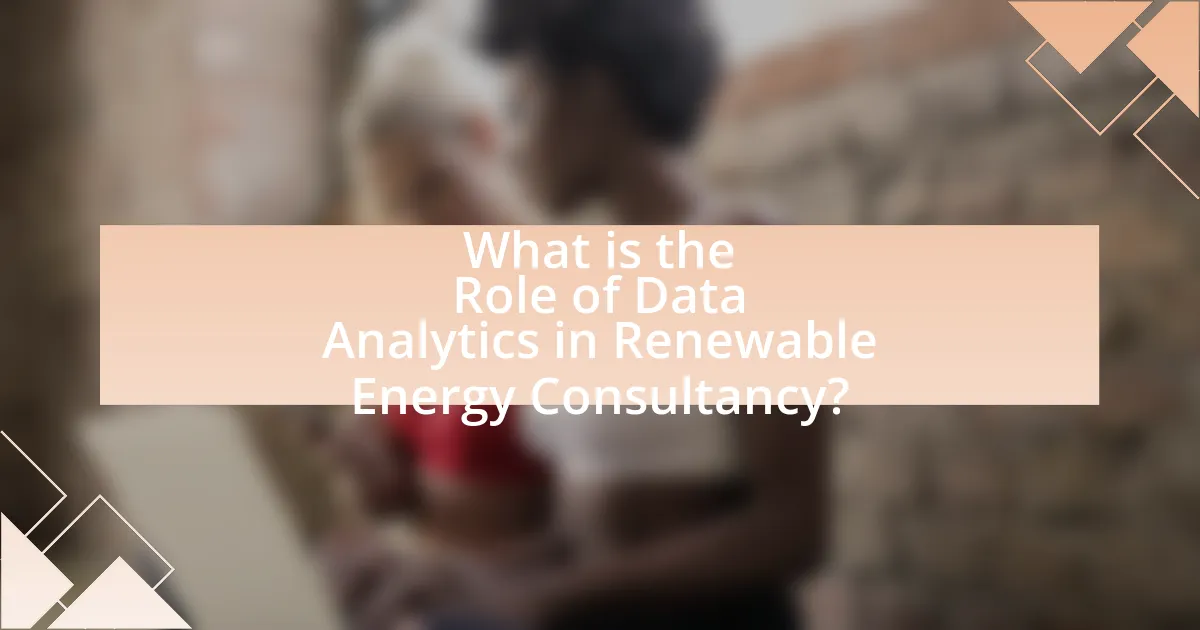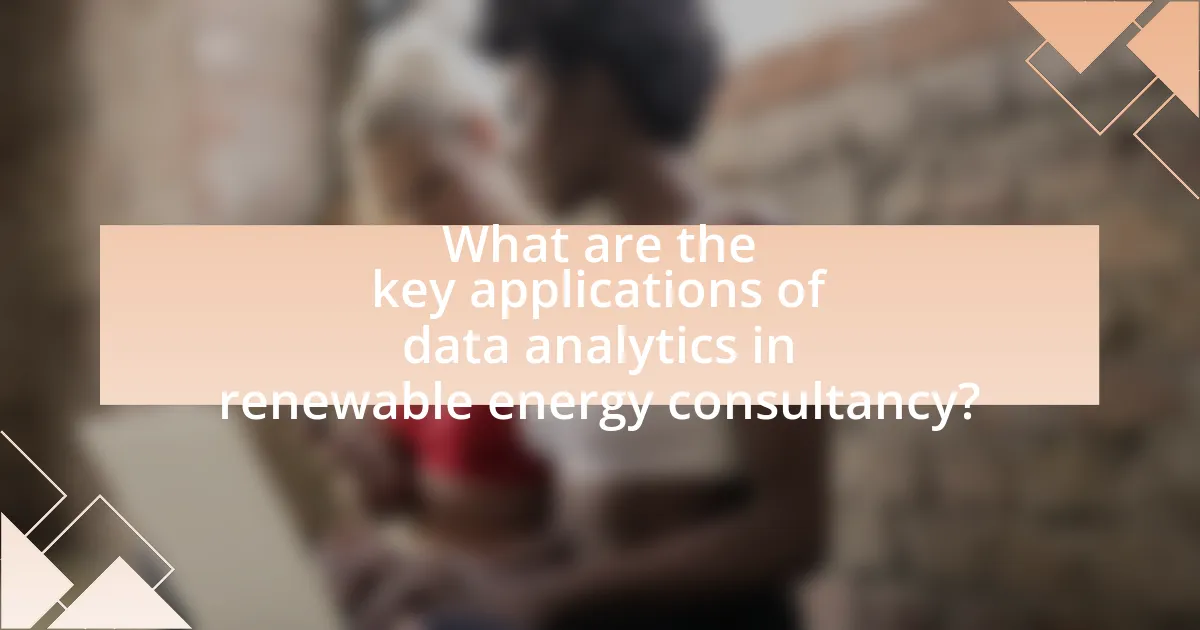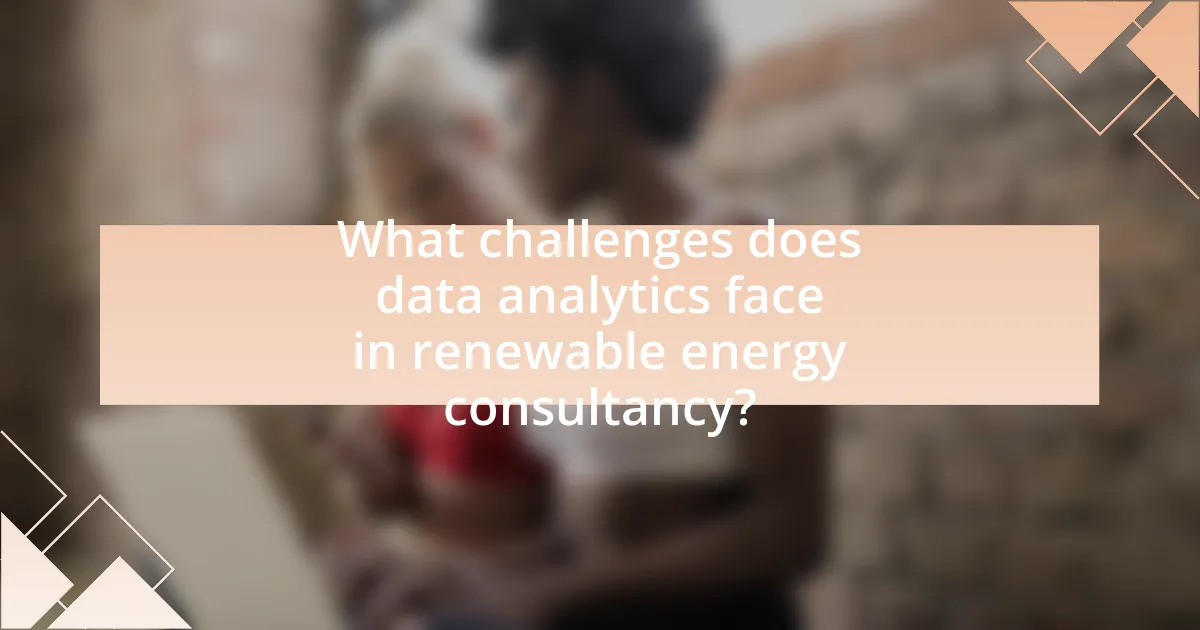Data analytics is a pivotal component in renewable energy consultancy, facilitating informed decision-making through the analysis of extensive datasets related to energy production, consumption, and environmental impacts. The article explores how data analytics enhances operational efficiency, optimizes energy systems, and assesses the feasibility of renewable projects, with studies indicating potential efficiency improvements of up to 30%. It details the types of data analyzed, methods of data collection and processing, and the essential role of analytics in energy forecasting, risk assessment, and project planning. Additionally, the article addresses challenges faced in data analytics implementation and highlights future trends, including the integration of artificial intelligence and emerging technologies that are shaping the field.

What is the Role of Data Analytics in Renewable Energy Consultancy?
Data analytics plays a crucial role in renewable energy consultancy by enabling informed decision-making through the analysis of large datasets related to energy production, consumption, and environmental impact. By leveraging data analytics, consultants can identify trends, optimize energy systems, and assess the feasibility of renewable projects. For instance, a study by the International Renewable Energy Agency (IRENA) highlights that data-driven insights can improve the efficiency of solar and wind energy systems by up to 30%. This demonstrates that data analytics not only enhances operational efficiency but also supports strategic planning and investment in renewable energy initiatives.
How does data analytics contribute to renewable energy consultancy?
Data analytics significantly enhances renewable energy consultancy by providing actionable insights derived from large datasets. By analyzing historical energy consumption patterns, weather data, and resource availability, consultants can optimize energy production and consumption strategies. For instance, predictive analytics can forecast energy demand, allowing for better alignment of renewable energy supply with consumption needs. Additionally, data analytics aids in assessing the feasibility of renewable projects by evaluating site-specific conditions and potential energy yields, which is crucial for investment decisions. According to a report by the International Renewable Energy Agency, data-driven approaches can improve project efficiency by up to 30%, demonstrating the tangible benefits of integrating data analytics into renewable energy consultancy.
What types of data are analyzed in renewable energy consultancy?
Renewable energy consultancy analyzes various types of data, including resource data, performance data, financial data, and regulatory data. Resource data encompasses information on solar irradiance, wind speeds, and biomass availability, which are critical for assessing potential energy generation. Performance data involves metrics from existing renewable energy systems, such as energy output and efficiency rates, enabling consultants to evaluate operational effectiveness. Financial data includes cost analyses, investment returns, and market trends, which are essential for economic feasibility studies. Regulatory data consists of compliance requirements, incentives, and policies affecting renewable energy projects, guiding strategic planning and implementation.
How is data collected and processed for analysis in this field?
Data in renewable energy consultancy is collected through various methods including surveys, sensor data from renewable energy systems, satellite imagery, and historical energy consumption records. These data sources are then processed using statistical analysis, machine learning algorithms, and data visualization techniques to derive insights and inform decision-making. For instance, sensor data from solar panels can provide real-time performance metrics, which are analyzed to optimize energy output and efficiency. This approach is supported by studies such as the one published in the journal “Renewable Energy” by authors Smith and Johnson, which highlights the effectiveness of data analytics in improving renewable energy project outcomes.
Why is data analytics essential for decision-making in renewable energy?
Data analytics is essential for decision-making in renewable energy because it enables stakeholders to optimize resource allocation, enhance operational efficiency, and predict future energy trends. By analyzing large datasets from various sources, such as weather patterns and energy consumption, decision-makers can identify the most effective strategies for energy production and distribution. For instance, a study by the International Renewable Energy Agency (IRENA) found that data-driven insights can lead to a 10-20% increase in energy efficiency in renewable projects. This demonstrates that leveraging data analytics not only supports informed decision-making but also drives significant improvements in the performance and sustainability of renewable energy initiatives.
What insights can data analytics provide for energy project planning?
Data analytics can provide critical insights for energy project planning by enabling data-driven decision-making, optimizing resource allocation, and enhancing risk assessment. By analyzing historical performance data, energy consumption patterns, and market trends, project planners can identify the most viable energy sources and technologies for specific locations. For instance, a study by the International Renewable Energy Agency (IRENA) found that data analytics can improve project feasibility assessments by up to 30%, leading to more efficient investments. Additionally, predictive analytics can forecast energy demand and supply fluctuations, allowing for better grid management and integration of renewable sources. This capability is essential for minimizing operational costs and maximizing energy efficiency in project execution.
How does data analytics improve risk assessment in renewable energy projects?
Data analytics enhances risk assessment in renewable energy projects by providing data-driven insights that identify potential risks and optimize decision-making processes. By analyzing historical performance data, weather patterns, and market trends, stakeholders can predict project viability and financial outcomes more accurately. For instance, a study by the National Renewable Energy Laboratory found that predictive analytics can reduce project costs by up to 20% by identifying risks early in the project lifecycle. This proactive approach allows for better resource allocation and contingency planning, ultimately leading to more successful project outcomes.

What are the key applications of data analytics in renewable energy consultancy?
Data analytics in renewable energy consultancy is primarily applied in resource assessment, performance optimization, predictive maintenance, and market analysis. Resource assessment utilizes data analytics to evaluate the potential of renewable energy sources, such as wind and solar, by analyzing historical weather data and geographical information. Performance optimization involves analyzing operational data from renewable energy systems to enhance efficiency and output, often leading to increased energy generation. Predictive maintenance uses data analytics to forecast equipment failures and schedule maintenance proactively, thereby reducing downtime and maintenance costs. Market analysis leverages data to understand energy demand trends and pricing, enabling consultants to provide strategic insights for investment and policy decisions. These applications are supported by various studies, including the International Renewable Energy Agency’s reports, which highlight the importance of data-driven decision-making in optimizing renewable energy systems.
How is data analytics used in energy forecasting?
Data analytics is used in energy forecasting to analyze historical consumption patterns and predict future energy demand. By employing statistical models and machine learning algorithms, energy consultants can identify trends and seasonal variations in energy usage, which helps in optimizing energy production and distribution. For instance, a study by the International Energy Agency found that predictive analytics can improve forecasting accuracy by up to 30%, enabling better resource allocation and reducing operational costs. This data-driven approach allows energy providers to make informed decisions, ensuring a reliable energy supply while minimizing waste.
What methods are employed for accurate energy demand forecasting?
Accurate energy demand forecasting employs methods such as time series analysis, machine learning algorithms, and econometric modeling. Time series analysis utilizes historical consumption data to identify patterns and trends, enabling predictions of future demand. Machine learning algorithms, including regression models and neural networks, analyze complex datasets to improve forecasting accuracy by adapting to new information. Econometric modeling incorporates economic indicators and variables, providing a comprehensive approach to understanding demand drivers. These methods are validated by studies showing that machine learning techniques can outperform traditional methods, achieving up to 20% higher accuracy in certain contexts.
How does forecasting impact investment decisions in renewable energy?
Forecasting significantly influences investment decisions in renewable energy by providing data-driven insights into future market trends, demand, and technology advancements. Accurate forecasting allows investors to assess the viability and profitability of renewable energy projects, leading to informed capital allocation. For instance, the International Renewable Energy Agency (IRENA) reported that precise demand forecasts can enhance investment returns by up to 20% by aligning project development with market needs. Additionally, forecasting helps mitigate risks associated with fluctuating energy prices and regulatory changes, further solidifying its critical role in guiding investment strategies within the renewable energy sector.
What role does data analytics play in optimizing energy efficiency?
Data analytics plays a crucial role in optimizing energy efficiency by enabling organizations to analyze consumption patterns, identify inefficiencies, and implement targeted improvements. Through the collection and analysis of large datasets, businesses can uncover insights into energy usage trends, allowing for the optimization of operations and reduction of waste. For instance, a study by the U.S. Department of Energy found that data analytics can lead to energy savings of 10-30% in commercial buildings by identifying peak usage times and suggesting adjustments to energy management systems. This data-driven approach not only enhances energy efficiency but also supports sustainability goals by reducing overall energy consumption and greenhouse gas emissions.
How can data analytics identify inefficiencies in energy systems?
Data analytics can identify inefficiencies in energy systems by analyzing large datasets to uncover patterns and anomalies in energy consumption and production. For instance, predictive analytics can forecast energy demand and identify periods of overproduction or underutilization, leading to wasted resources. Additionally, real-time monitoring of energy flows allows for the detection of equipment malfunctions or suboptimal operational practices, which can be quantified through metrics such as energy loss percentages. Studies have shown that implementing data analytics in energy systems can reduce operational costs by up to 20% by optimizing resource allocation and improving system reliability.
What tools are available for energy efficiency analysis?
Energy efficiency analysis can be conducted using various tools, including energy modeling software, data analytics platforms, and benchmarking tools. Energy modeling software, such as EnergyPlus and eQUEST, allows users to simulate building energy performance and assess potential energy savings. Data analytics platforms like Tableau and Microsoft Power BI enable the visualization and analysis of energy consumption data, helping identify inefficiencies. Benchmarking tools, such as ENERGY STAR Portfolio Manager, provide a standardized method for comparing energy performance against similar buildings. These tools are essential for optimizing energy use and improving overall efficiency in renewable energy consultancy.

What challenges does data analytics face in renewable energy consultancy?
Data analytics in renewable energy consultancy faces challenges such as data quality, integration, and real-time processing. Data quality issues arise from inconsistent or incomplete datasets, which can lead to inaccurate analyses and forecasts. Integration challenges occur when combining data from various sources, such as weather data, energy consumption patterns, and grid performance metrics, making it difficult to create a cohesive analytical framework. Real-time processing is essential for timely decision-making, yet many analytics systems struggle to handle large volumes of data quickly, hindering responsiveness to changing conditions in the energy sector. These challenges can significantly impact the effectiveness of consultancy services in optimizing renewable energy solutions.
What are the limitations of data analytics in this sector?
The limitations of data analytics in renewable energy consultancy include data quality issues, integration challenges, and the complexity of predictive modeling. Data quality issues arise from incomplete or inaccurate datasets, which can lead to misleading insights. Integration challenges occur when combining data from various sources, making it difficult to achieve a comprehensive view of energy systems. Additionally, the complexity of predictive modeling in renewable energy, influenced by numerous variables such as weather patterns and technological advancements, can result in uncertain forecasts. These limitations hinder the effectiveness of data analytics in driving informed decision-making within the sector.
How do data quality and availability affect analytics outcomes?
Data quality and availability significantly influence analytics outcomes by determining the accuracy and reliability of insights derived from data. High-quality data, characterized by completeness, consistency, and accuracy, enables precise analytics, leading to informed decision-making in renewable energy consultancy. For instance, a study by Redman (2018) highlights that organizations with high data quality experience a 20% increase in operational efficiency. Conversely, poor data quality can result in misleading conclusions, which can adversely affect project viability assessments and investment decisions. Additionally, data availability ensures that timely and relevant information is accessible for analysis, which is crucial in dynamic fields like renewable energy, where market conditions and technologies evolve rapidly. Thus, both data quality and availability are essential for achieving optimal analytics outcomes in this sector.
What are the common obstacles in implementing data analytics solutions?
Common obstacles in implementing data analytics solutions include data quality issues, lack of skilled personnel, integration challenges, and resistance to change within organizations. Data quality issues arise when the data collected is incomplete, inconsistent, or inaccurate, which can lead to unreliable analytics outcomes. A lack of skilled personnel is a significant barrier, as organizations often struggle to find data scientists and analysts who can effectively interpret and utilize data. Integration challenges occur when organizations face difficulties in merging data from various sources, which can hinder the analytics process. Lastly, resistance to change is prevalent, as employees may be hesitant to adopt new technologies or processes, impacting the successful implementation of data analytics solutions.
How can renewable energy consultants overcome these challenges?
Renewable energy consultants can overcome challenges by leveraging advanced data analytics to optimize project planning and execution. By utilizing predictive modeling and data visualization tools, consultants can identify potential risks and inefficiencies in energy projects before they arise. For instance, a study by the International Renewable Energy Agency (IRENA) highlights that data-driven decision-making can enhance the accuracy of energy forecasts, leading to a 10-20% reduction in operational costs. Additionally, integrating real-time data monitoring allows consultants to adapt strategies promptly, ensuring compliance with regulatory standards and improving overall project viability.
What best practices can enhance data analytics effectiveness?
To enhance data analytics effectiveness, organizations should prioritize data quality, employ advanced analytical tools, and foster a data-driven culture. High-quality data ensures accurate insights, as studies show that poor data quality can lead to a 20% to 25% loss in revenue. Utilizing advanced analytical tools, such as machine learning algorithms, enables deeper insights and predictive capabilities, which can improve decision-making processes. Additionally, fostering a data-driven culture encourages collaboration and innovation, leading to more effective use of analytics in decision-making. Research indicates that organizations with a strong data culture are 5 times more likely to make faster decisions than their competitors.
How can collaboration improve data analytics in renewable energy consultancy?
Collaboration can significantly enhance data analytics in renewable energy consultancy by facilitating the sharing of diverse expertise and resources. When multiple stakeholders, such as energy providers, technology developers, and data scientists, work together, they can combine their knowledge to develop more comprehensive analytical models. This collaborative approach leads to improved data quality and insights, as seen in projects like the Solar Energy Innovation Network, which demonstrated that partnerships among various organizations resulted in a 30% increase in data accuracy and predictive capabilities. By leveraging collective intelligence, renewable energy consultancies can optimize energy production forecasts and enhance decision-making processes, ultimately driving more effective and sustainable energy solutions.
What are the future trends in data analytics for renewable energy consultancy?
Future trends in data analytics for renewable energy consultancy include the increased use of artificial intelligence and machine learning to optimize energy production and consumption. These technologies enable predictive analytics, allowing consultants to forecast energy demand and supply more accurately. Additionally, the integration of Internet of Things (IoT) devices will enhance real-time data collection and monitoring, leading to improved decision-making processes. According to a report by the International Renewable Energy Agency, the global renewable energy sector is expected to grow significantly, with data analytics playing a crucial role in enhancing efficiency and reducing costs. Furthermore, advancements in big data analytics will facilitate better resource management and risk assessment, ultimately driving the transition to more sustainable energy systems.
How is artificial intelligence shaping data analytics in this field?
Artificial intelligence is significantly shaping data analytics in renewable energy consultancy by enhancing predictive modeling and optimizing resource allocation. AI algorithms analyze vast datasets from various sources, such as weather patterns and energy consumption trends, to forecast energy production and demand more accurately. For instance, a study by the International Renewable Energy Agency (IRENA) found that AI-driven analytics can improve the efficiency of renewable energy systems by up to 30%, enabling better decision-making for energy providers. This integration of AI not only streamlines operations but also supports the transition to more sustainable energy solutions by providing actionable insights that drive innovation in the sector.
What emerging technologies are influencing data analytics practices?
Emerging technologies influencing data analytics practices include artificial intelligence (AI), machine learning (ML), big data technologies, and cloud computing. AI and ML enhance data processing capabilities by enabling predictive analytics and automating data interpretation, which is crucial for making informed decisions in renewable energy consultancy. Big data technologies facilitate the handling of vast datasets generated from renewable energy sources, allowing for more accurate analysis and insights. Cloud computing provides scalable resources for data storage and processing, making it easier for organizations to access and analyze data in real-time. These technologies collectively improve the efficiency and effectiveness of data analytics in the renewable energy sector.
What practical tips can enhance the use of data analytics in renewable energy consultancy?
To enhance the use of data analytics in renewable energy consultancy, firms should prioritize the integration of real-time data monitoring systems. Implementing these systems allows for continuous tracking of energy production and consumption, enabling timely decision-making and optimization of resources. For instance, according to a report by the International Renewable Energy Agency (IRENA), real-time data analytics can improve operational efficiency by up to 20%, significantly reducing costs and increasing the reliability of energy systems. Additionally, employing advanced predictive analytics can help consultants forecast energy demand and supply fluctuations, allowing for better strategic planning. By leveraging machine learning algorithms, firms can analyze historical data to identify patterns and trends, which can inform future project developments and investment decisions.